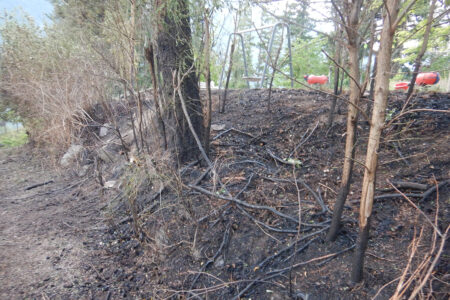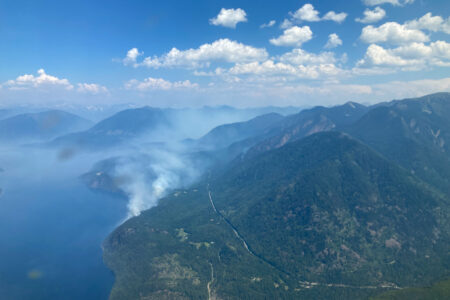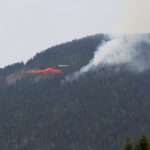Critical priorities identified for Nelson Transit: B.C. Transit
Although the service is performing ‘really well,’ transit service is Nelson is facing five critical strategic plan priorities, a B.C. Transit representative says.
Daynika White, manager of government relations for B.C. Transit, gave an overview of the transit model — with a focus on Nelson — during the Sept. 26 City council meeting, delivering a glowing picture of transit in the city.
Compared to services of a similar size in B.C., Nelson Transit was able to earn a high operating cost recovery, transit trips per service hour, total passenger trips and total revenue.
“Nelson Transit is consistently reliable and has great on-time performance,” she said. “It has been delivering 99.8 per cent service, an excellent performance indicator.”
Even with this excellent performance ridership is still recovering from pre-pandemic performance levels, but trending well in the right direction, White added.
Nor does that mean the service is not without challenges, said White. Of the five strategic priorities deemed critical, all have to do with expanding service, with two new round trips proposed for the Kootenay Connector (99) as one of the proposed service change options.
The Columbia Connector (98) could also see two new weekday trips, while the North Shore (10) could see an extension of the weekday (4:04 p.m.) trip to Balfour. Another option could be to introduce two new weekday trips to Selkirk College (33) and add one additional morning weekday peak overload trip to the Fairview (2) route.
“(The) 99 and 98 were recognized at capacity several years ago, so we are looking for expansion now as the (backbone of regional system),” said White. “So we are really picking things back up this year, and really re-assessing those priorities.”
One of the major short-term service priorities will be the introduction of basic service between Salmo, Ymir and Nelson — three round trips to coincide with the start and end of the high school academic day and office end time. BC Transit would also seek to extend service from Salmo to Fruitvale.
The rise of the Salmo service would likely spell the end of the 15 Perrier (Road) service, slated to be supplanted by the new service creation.
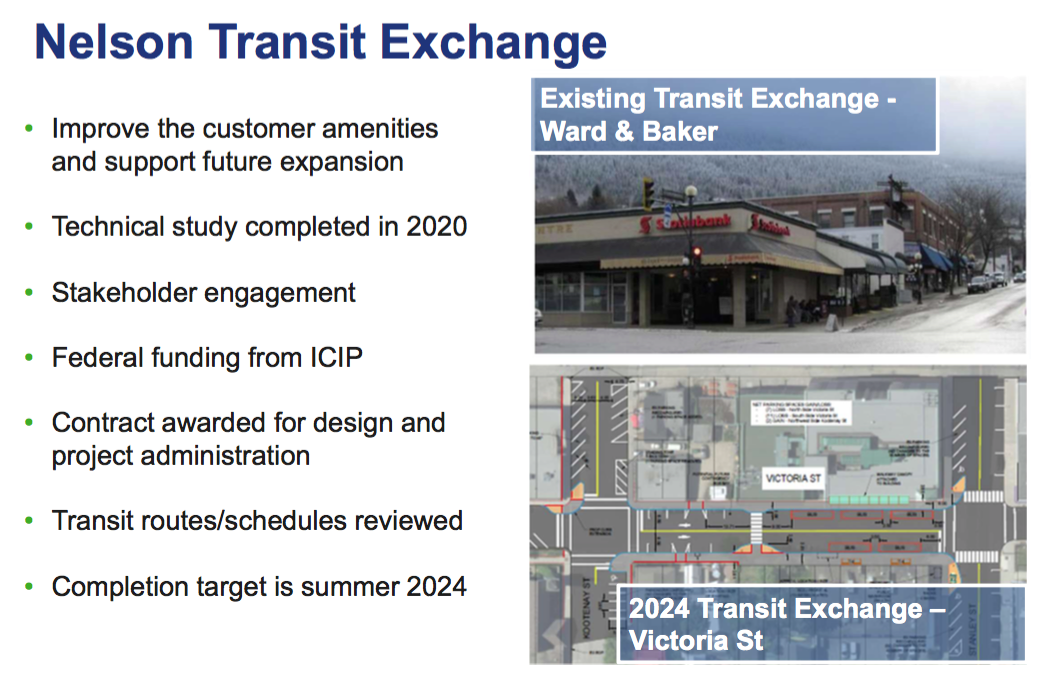
The 72 Salmo to Nelson health connection route could be changed, with BC Transit looking to “seek permission from Interior Health to adjust trip times and change the fare structure” of the health connection.
Short-term priorities also include the 98 Columbia Connector, with all trips going to Selkirk College, and two local proposed changes to Castlegar service: extending evening service within Castlegar to better align with service standards and equity; introduction of additional peak service to distinguish route 33 from 98; and improving route 32 Columbia and 36 Ootischenia.
Further north in the region, the 53 Edgewood could receive additional run time to address ferry run-time issues, and the Nakusp local could be adjusted in its service times to maintain service levels.
In order to extend transit service to areas untouched, there will also be a Procter and Harrop transit feasibility study scheduled for 2023/24 as part of the planning updates.

Currently, the priorities are being reviewed from the plan, with the transit improvement process beginning in April, and the expected approval from local governments — through a memorandum of understanding — in August.
Ultimately, if the province approves the changes and the funding, implementation of the expansions could begin in July 2024 and onwards.
Recovery mode
It could be four years before public transit ridership in the region returns to pre-COVID ridership levels, according to a regional district report.
Public transit ridership is still in recovery mode, noted Regional District of Central Kootenay (RDCK) research analyst Tom Dool in his annual operating agreement report to the board of directors earlier this year.
“Depending on the route and time of day current ridership levels fluctuate between 60 per cent to 80 per cent of pre-COVID levels,” he said. “Current forecasts do not expect a return to pre-COVID ridership levels until 2025.”
For this reason, BC Transit has declined to fund any service expansion in 2022-23, explained Dool.
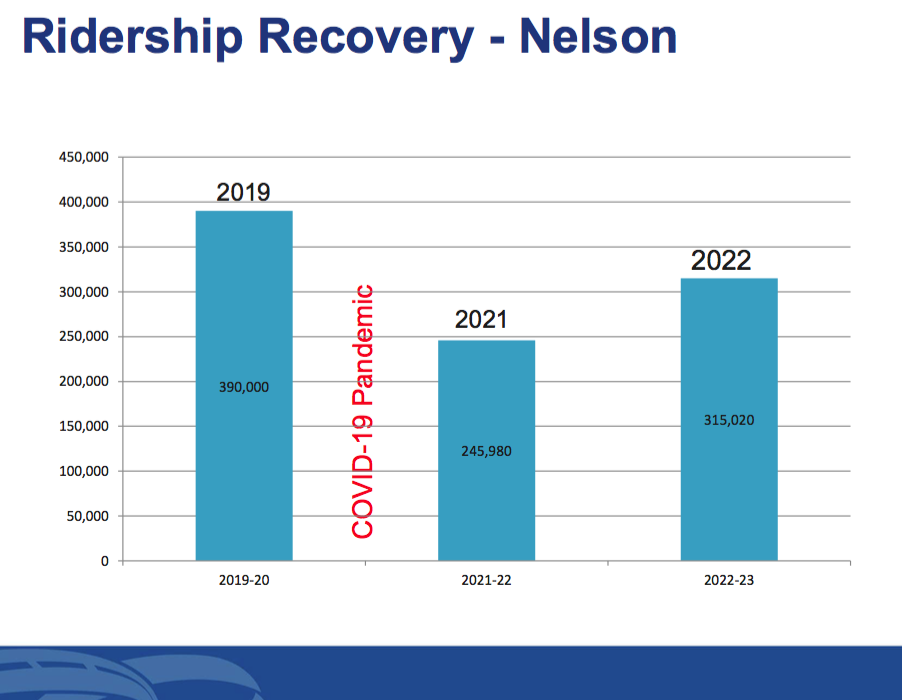
“However, the local government timelines required for service expansion, particularly where new rolling stock are required extend beyond this period,” he continued.
Dool wrote that, under the direction of the board, the RDCK would continue with the work outlined in the Creston Valley and West Kootenay Transit future service plans.
The annual operating agreement between the RDCK and BC Transit is for the provision of a public passenger transportation system for the period of April 1, 2022 to March 31, 2023. The operating agreement details fares, service specifications and budgets for the provincial fiscal year.
Costs, fuel increase
The local transit authority is on its own when it comes to inflation and increasing costs.
B.C. Transit will no longer fund shared operating reserves on their side of the shared operating budget, as directed by the Auditor General of BC, noted Dool.
“This requires that local governments take into consideration the need for operating reserves to cope with fuel price volatility, increased operating costs and reduced revenue,” he wrote.
“Operating reserves, exclusive to local government, have been established in the shared BCT/local government operating budget as local transit funds.”
The remaining balances of shared operating reserves and safe restart funding have been transferred into these accounts, Dool pointed out in his report.
Increased volatility in fuel pricing and operations costs have resulted in a $41,548 (two per cent) rise in the projected local government share of public transit costs, he wrote in his report.
“Local transit fund reserves within the shared operating budget are intended to address operating budget shortfalls of this sort,” Dool explained.
The process
The service expansion process must undergo several steps in order to come to fruition.
The first step is the update of the service plan with the completed planning work on the transit future service plan for Kootenay Lake West, Castlegar and area, and Nelson — which occurred in 2021/22.
The next step is for the annual update of the three-year expansion (request) agreement, with local governments agreeing to their share in the cost. If the agreement is not signed by local governments the next step of approaching the province for funding completion will not occur.
All requests then are taken by BC Transit to the province for the other portion of the funding, with the request being approved (or not approved) in the announcement of the B.C. budget in the third week of February.
Carbon crunch
BC Transit is in the beginning stages of its low carbon fleet program across the province and within West Kootenay Transit.
Towards that end, the organization has committed to transition to an electric fleet across the province by 2040.
The provincial carbon emission reduction targets are 16 per cent by 2025, 40 per cent by 2030 and 60 per cent by 2040, with an end goal of 80 per cent by 2050.




